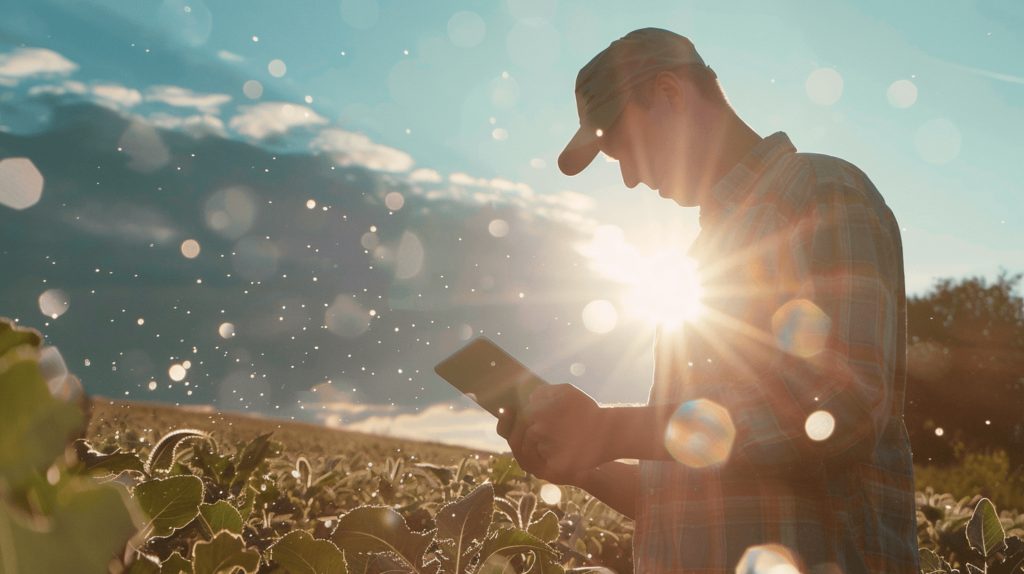Introduction

As global agriculture faces challenges like climate change, resource scarcity, and the need for sustainable practices, technology is stepping in as a game-changer. One of the most promising advancements is remote agritech monitoring, which leverages tools such as IoT sensors, drones, and satellite imagery to deliver real-time data on everything from soil quality to crop health. However, not every agribusiness has the resources to adopt and manage these sophisticated systems internally—that’s where outsourcing comes into play.
Outsourcing remote agritech monitoring services allows farmers and agribusinesses to harness cutting-edge technology without the burden of high costs and technical expertise. In this guide, we’ll explore the compelling reasons why outsourcing might be the most practical and efficient option for many agribusinesses and take a closer look at the benefits, types of services available, and examples of real-world applications.
The Value of Remote Agritech Monitoring

Remote agritech monitoring involves using technology to gather and analyze data across agricultural operations. Unlike traditional monitoring methods, remote monitoring allows for constant, real-time tracking of critical variables such as soil moisture, crop growth, weather conditions, and even machinery health—all without physically being on the farm.
For instance, a farmer in California might rely on a network of sensors and satellite data to monitor soil moisture and rainfall patterns across hundreds of acres. Instead of waiting until signs of stress appear on plants, the farmer receives alerts when soil conditions start to deteriorate, enabling timely interventions. The continuous flow of data helps optimize resource usage, boost yield quality, and reduce costs, making it a valuable tool for modern agriculture.
Key Benefits for Agribusinesses
Increased Efficiency: Remote monitoring reduces time spent on manual inspections and allows farmers to respond faster to issues, such as water shortages or pest infestations.
Enhanced Sustainability: By tracking and adjusting resources like water and fertilizer in real-time, remote monitoring promotes efficient resource use, reducing waste and environmental impact.
Data-Driven Decisions: Agritech monitoring doesn’t just capture data; it provides actionable insights, enabling agribusinesses to make informed decisions that improve productivity and sustainability.
Scalability: Remote monitoring systems can be scaled to fit farms of any size, from small family farms to massive commercial operations, making it an adaptable solution for diverse needs.
Example: Consider a vineyard using remote agritech monitoring. Soil sensors help monitor moisture levels, allowing the vintner to manage irrigation precisely. This conserves water and ensures the grapes receive just the right amount of hydration, ultimately improving the quality of the wine.
Benefits of Outsourcing Agritech Monitoring Services

Given the advantages of remote monitoring, why would a business choose to outsource these services rather than handle them in-house? Here’s why outsourcing agritech monitoring is often a smarter, more cost-effective solution:
Cost-Effectiveness
Implementing a remote monitoring system in-house requires significant investment in technology, software, and personnel. Many small to medium-sized agribusinesses find it more practical to partner with an experienced outsourcing provider. By outsourcing, businesses avoid the substantial upfront costs and gain access to advanced tools without needing to invest in their own infrastructure.
Example: A medium-sized farming operation might pay hefty amounts for sensors, data management software, and skilled staff to monitor and analyze the data. By outsourcing, they only pay for the services they need, when they need them, without the ongoing maintenance or training costs.
Access to Advanced Technology
Technology in agritech evolves quickly. Outsourcing partners specializing in remote agritech monitoring often have access to the latest tools and software, which means that businesses benefit from cutting-edge technology without having to constantly upgrade their own systems. Drones, artificial intelligence (AI), and machine learning algorithms that predict crop health and detect pest infestations are a few examples of the tech accessible through outsourcing partnerships.
Example: An agritech outsourcing provider may offer satellite-based data analysis that enables farmers to spot early signs of drought stress, nutrient deficiencies, or pest invasions. This data empowers proactive intervention strategies, helping farmers prevent potential losses.
Improved Data Accuracy and Expertise
Agritech monitoring requires not only the right tools but also the expertise to interpret complex data. Outsourcing firms employ specialists in data analysis and agricultural technology, which means that businesses can rely on precise insights rather than just raw data. These firms often provide customized reports that are easy to understand and implement, saving time and ensuring accuracy in decision-making.
Example: In dairy farming, outsourced monitoring can track health indicators in cows, such as body temperature, movement, and feeding patterns. Skilled analysts can interpret this data to detect early signs of illness, allowing farmers to address issues promptly and prevent outbreaks.
Types of Remote Agritech Monitoring Services Available

When it comes to outsourcing agritech monitoring, there are several types of services that cater to specific needs. Here’s a breakdown of the most popular options:
Environmental Monitoring
This includes tracking weather patterns, soil health, and water quality. With outsourced environmental monitoring, farmers gain insights into soil pH, nutrient levels, moisture, and temperature—factors that directly impact crop health and yield.
Example: An outsourced environmental monitoring service might use soil sensors and weather forecasts to alert farmers when conditions are optimal for planting, thus improving crop outcomes.
Crop Health Monitoring
Leveraging remote sensing and drones equipped with infrared and multispectral imaging, outsourced services can assess crop health by detecting stress factors such as disease, pests, or nutrient deficiencies. These insights help agribusinesses prevent or address issues before they escalate.
Example: In rice farming, drone imagery can reveal areas with inadequate water supply, allowing farmers to target irrigation in those specific areas rather than water the entire field unnecessarily.
Equipment and Machinery Monitoring
Beyond crop health, monitoring farm machinery and equipment ensures operational efficiency. By tracking equipment usage, performance, and maintenance needs, outsourcing partners help prevent costly breakdowns and improve the lifespan of machinery.
Example: A company specializing in equipment monitoring may use IoT sensors to track the hours of operation of tractors, flagging when maintenance is due. This minimizes the risk of unexpected breakdowns during peak harvest times.
Choosing the Right Agritech Monitoring Outsourcing Partner

Selecting the right partner for agritech monitoring is like finding the perfect fit in any high-stakes relationship—it requires alignment in expertise, values, and long-term goals. An effective outsourcing partner should not only understand agricultural technology but should also have a deep appreciation for the nuances and demands of modern farming. Here are some key considerations to keep in mind:
Industry Experience and Reputation
Look for a provider with a proven track record in agritech monitoring, ideally one that has partnered with farms or agribusinesses similar to yours. A reputable outsourcing partner brings not only technical expertise but also insights into best practices that can be applied across various agricultural contexts.
Example: If a provider has extensive experience in large-scale grain farming, they’re more likely to understand the unique challenges and requirements of managing grain yield remotely and optimizing storage.
Technology Compatibility
Agritech monitoring often requires integrating new tools with existing systems. A strong partner should be able to customize their solutions to seamlessly work with your current operations, whether it’s software that complements your farm management system or hardware that adapts to the infrastructure on your farm.
Example: Imagine a vineyard using specific sensors for soil moisture—an ideal outsourcing partner would be able to work with that hardware or offer seamless integration with similar tools, ensuring data continuity without the need for costly replacements.
Data Security and Privacy
In an era where data is as valuable as the crops themselves, security should be a top priority. An agritech monitoring partner should employ robust data protection measures to safeguard your farm’s sensitive information. Beyond technology, their policies should align with regulatory requirements, especially if your farm operates across regions with different data security laws.
Example: A partner who offers end-to-end data encryption and complies with regional regulations ensures that your crop data and operational insights remain secure, reducing risks associated with data breaches or unauthorized access.
Flexibility and Scalability
Farming needs can change from season to season. A versatile partner should be able to scale their services up or down according to your business cycles. This adaptability not only saves costs but also makes it easier to test and implement new technologies as your operation grows.
Future Trends in Remote Agritech Monitoring and Outsourcing

The agritech industry is constantly evolving, driven by cutting-edge advancements that make monitoring more effective, sustainable, and data-driven than ever before. Here are some key trends shaping the future of remote agritech monitoring and outsourcing:
AI and Machine Learning for Precision Agriculture
Artificial intelligence (AI) and machine learning are transforming agritech monitoring by enabling predictive analytics that help farmers make proactive decisions. These technologies can analyze vast amounts of data from sensors, weather forecasts, and crop health indicators to predict everything from optimal harvest times to potential pest outbreaks.
Example: An AI-powered monitoring system could forecast a pest infestation before it becomes visible, allowing farmers to implement preventive measures that save both crops and costs. By working with an outsourcing partner that employs AI, farmers can leverage this advanced technology without needing an in-house AI team.
Sustainability and Climate-Resilient Farming
With the global focus on sustainability, remote monitoring is increasingly being used to minimize environmental impact. Monitoring systems now help farmers track water usage, optimize fertilizer application, and manage crop health in ways that are both economically and environmentally sustainable. Outsourcing partners specializing in sustainability bring valuable knowledge and tools to help farms achieve greener practices.
Example: A sustainable-focused outsourcing provider might help a farmer measure and reduce water waste by adjusting irrigation based on soil moisture levels, leading to water savings that contribute to both environmental conservation and cost reduction.
Blockchain for Transparent and Secure Data Sharing
As agritech monitoring becomes more data-intensive, blockchain is emerging as a solution for secure, transparent data sharing. Blockchain technology can validate and protect data across the supply chain, giving all stakeholders—from farmers to distributors—access to reliable, unaltered data.
Example: By partnering with an outsourcing provider using blockchain, a farmer could offer transparency on crop quality and growth practices to buyers, potentially securing better contracts or gaining a competitive edge in sustainable markets.
How to Get Started with Agritech Monitoring Outsourcing

Beginning your journey with outsourced agritech monitoring can feel like a significant step, but with the right approach, it’s a process that can be seamless, efficient, and impactful for your business. Here’s a step-by-step guide to help you get started:
Assess Your Monitoring Needs
Identify the areas of your operation that could benefit the most from remote monitoring, whether it’s soil quality, crop health, machinery maintenance, or environmental conditions. Understanding your unique needs will help narrow down potential outsourcing providers that specialize in these areas.
Research and Shortlist Potential Partners
Gather information on reputable outsourcing partners who align with your specific agribusiness requirements. Compare factors such as expertise, technology, client testimonials, and support services. Be sure to ask for case studies or client references to get a better sense of their impact.
Establish Clear Goals and KPIs
Before entering into a contract, define clear objectives for what you want the partnership to achieve, along with measurable key performance indicators (KPIs). This ensures both you and the provider have a shared vision and framework for success.
Trial Period
Many outsourcing partners offer trial periods or phased rollouts. Use this time to evaluate the quality of service and effectiveness of the monitoring tools. A trial period provides valuable insights into how the partnership will work long-term.
Conclusion

In today’s dynamic agricultural landscape, remote agritech monitoring has become an invaluable asset, enabling farmers and agribusinesses to harness the power of data to drive smarter, more sustainable decisions. Through outsourcing, businesses can access advanced technology, expert analysis, and cost savings that would be challenging to achieve independently. By carefully selecting a reliable partner, agribusinesses of all sizes can revolutionize their operations, ensuring greater efficiency and sustainability for the future.
As you consider the possibilities that remote agritech monitoring outsourcing offers, remember that it’s not just about technology—it’s about gaining a competitive edge, enhancing sustainability, and making impactful decisions that benefit both your business and the environment.
Ready to elevate your agricultural operations with top-tier agritech monitoring solutions? Explore our comprehensive guides on the latest in agritech, outsourcing strategies, and sustainability practices to unlock the full potential of your agribusiness. Discover a future where technology meets the earth, and let us help you pave the way to smarter farming.




